
views
Qualifying to Contact an Ombudsman

Ensure you have suffered a personal loss at the hands of a company. Keep in mind that you can only file a complaint with the ombudsman if you have suffered financial loss, personal hardship, or a personal injustice at the hands of a commercial organization. You must not be able to resolve the issue with the organization itself to get the ombudsman involved. Contacting an ombudsman is an alternative path to resolving disputes with companies when you aren’t ready to take the matter to a court of law or can’t afford to do so. Ombudsman services are free for any consumer to use.

Follow the internal complaints process of the company you have an issue with. Make sure you have exhausted all of the resources provided by the organization you have a dispute with for filing a formal complaint with them. Ombudsman will only investigate your case when you and the company are at a standstill.Tip: Ombudsman are also sometimes referred to as alternative dispute resolution (ADR) schemes. You can typically take complaints to the customer service department of any commercial organization. If there is an additional internal complaints process or department, they will be able to provide you with the necessary info to go through all the steps.

Request a letter of deadlock from the organization you have a dispute with. Send a formal request via mail or email to the company stating that your attempts to resolve the issue with the organization have been unsatisfactory and that you feel you have reached a deadlock situation. Ask the company for a letter of deadlock which states that they are in agreement and that you cannot resolve the dispute. You can find an example of a letter of deadlock request here: https://www.which.co.uk/consumer-rights/letter/letter-of-deadlock-request-before-going-to-the-ombudsman. Make sure to include any specific information in the letter such as a case reference number from the organization’s internal complaints process.
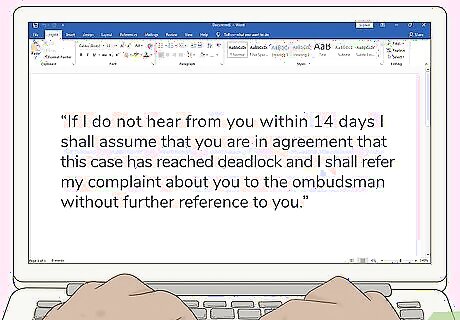
Inform the company that they have 14 days to comply with your request. State at the end of the request that if you do not receive a letter of deadlock from the company within 14 days, you will assume they are in agreement with the deadlock. Finish by saying that you will proceed to contact the ombudsman without any further notice after this time period. You must give the company a reasonable amount of time to respond to your formal request for a letter of deadlock. Two weeks is generally considered such an amount of time.

Contact the ombudsman when you receive a letter of deadlock. Wait to receive a response from the organization you have an issue with. You’re free to contact the ombudsman with your case as soon as the company replies with a letter of deadlock that states they are in agreement with you. If you don’t receive a response to your request, remember to keep waiting until 14 days have passed before you do anything further.

Proceed to contact the ombudsman after 14 days if you don’t get a response. It is acceptable to file a complaint with the ombudsman if you wait at least 14 days without getting a response to your request for a letter of deadlock from the company. This gives the company plenty of time to reply to you with the letter or an alternative solution. The principal condition for any ombudsman to investigate your case is that you can show you have tried and failed to resolve the dispute personally with the company. The fact that you sent a letter of deadlock request to the organization and received no response is enough to prove this.
Filing a Complaint with the Ombudsman
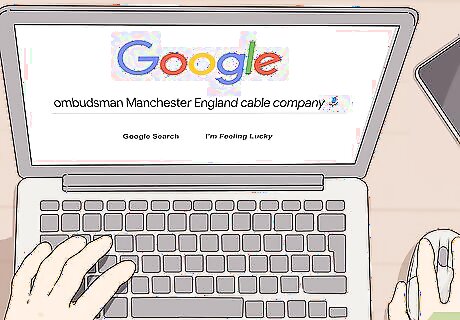
Search online for local ombudsman schemes that cover the right industry. There are various ombudsman groups, known as schemes, in different countries that cover specific types of companies in both the private and public sectors. Enter a search term like “ombudsman Manchester England cable company” if you live in Manchester, England to pull up sites of local ombudsman schemes that handle disputes with cable companies. For example, there are private sector ombudsman that cover the energy, financial, and even furniture industries. There are public sector ombudsman schemes for things like health services, parliaments, and prisons. Depending on where you live and want to file your complaint, ombudsman schemes may cover larger areas like states and provinces or smaller areas like cities.
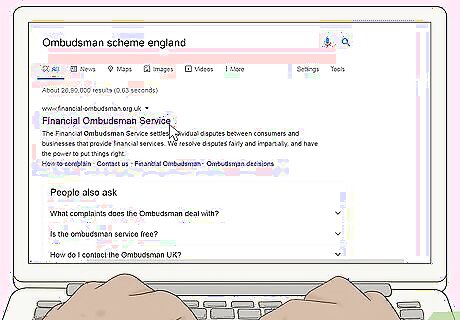
Check the scheme’s website to confirm the conditions for filing a complaint. Ombudsman scheme web pages generally have lots of information about when you can file a complaint, what types of complaints they handle, and how they resolve disputes. Read through all the informational pages on the website to make sure that contacting the ombudsman is appropriate for your case and still appeals to you.Tip: If you still aren’t sure whether you are ready to file a complaint or have further questions, just look for the help line number on the ombudsman scheme’s website and call it to discuss your questions and concerns with an actual person. Make sure to read through information about how they handle disputes and decide whether the possible outcomes are satisfactory. There may be limitations like caps on financial compensation, in which case you might decide that the possible resolution is not enough for you and choose to take the matter to court instead.
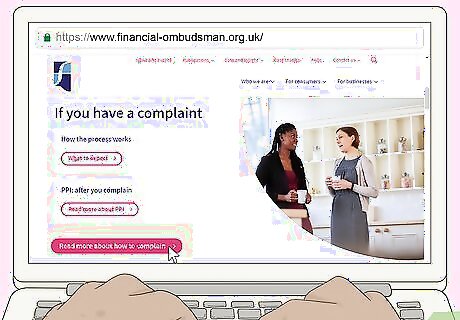
Browse the website to find the accepted methods for filing complaints. Look for a page titled something like “How to File a Complaint” or “File a Complaint” and read through the information to determine what contact channels are available for filing complaints. The ombudsman scheme might receive cases through an online form, email, mail, fax, in-person, or multiple methods. All the contact information, such as links to complaint forms, mailing addresses, phone numbers, and email addresses, is usually included on the same page along with all the information about how to file a complaint.
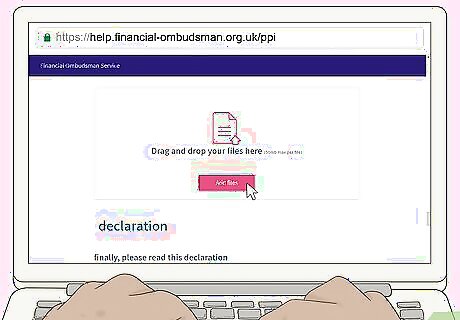
Submit the required information and documents via an accepted method. Include your name and address as well as the name and address of the company you are filing a complaint against. Give all the details of what the organization did wrong, how it caused you personal loss or suffering, what you did to try to resolve the dispute, and what you would like them to do to put things right. Make sure to include copies of all communications you had with the organization, including the request for a letter of deadlock and the letter of deadlock from the company if you received one back.

Wait up to 90 days for the ombudsman to review your case and reach a verdict. The ombudsman will take a look at all of the information you provided and give the company you have a dispute with a chance to explain their side. They will either rule in favor of you and suggest a remedy or will rule in favor of the company and you will not receive any kind of compensation. Remedies suggested by ombudsman vary greatly, but often include some kind of financial compensation for you. If the ombudsman has received repeated complaints about a particular organization, they may ask the company to change it policies or business practices. Most cases are resolved in less than 3 months, but certain cases may take longer depending on the complexity of the dispute. If you aren’t happy with the outcome, you can always decide to pursue your case in a court of law.




















Comments
0 comment